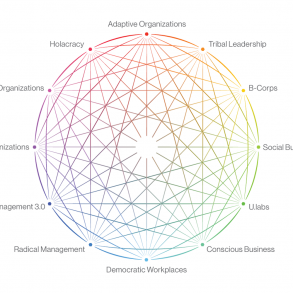By Ted J. Rau and originally published on medium.com

How can partnerships between organizations succeed?
This paper describes the ingredients of collaboration between organizations without a higher, “big tent” organization. The intention is to create a governance protocol that helps make collaboration easy, clear, nimble and empowering, and that allows collaboration to scale up or down depending on need, resources, and values.
The design principles draw from sociocratic design principles and decentralized, fractal, semi-autonomous collaboration.
The problem
Partnerships are vague. Whenever two organizations see the possibility of synergy, they often want to “partner”. But often, it is unclear what this is supposed to look like. Does partnering mean to list each other’s logos on our websites? Or does it mean creating complementary interfaces? Or does it mean doing things together? And if so, how much, and how deeply?
Decentralization and partnership. Decentralized organizations with distributed decision-making have a structural disadvantage compared to centralized organizations. Let’s imagine a centralized, hierarchical organization where decisions are made top-down. If the two leaders of two organizations decide to partner on an event, for example, they can each give directives to the marketing and the event planning department and make it happen.
Yet, in the case of a decentralized organization, it would have to be the leaders of the marketing departments of both organizations and the leaders of the event planning departments of both organizations to get together and decide together. This example shows that partnership can now exist on many levels and in many departments, and really only there because no directives can be given top-down.
Many-to-many relationships. In decentralized organizations, we need to embrace many-to-many relationships. Partnerships turn into direct agreements between parts or organizations. For example, it’s possible that Organization A has a mission-level partnership with Organization B, but Organization B also has an event-level partnership with Organization C. Each partnership will create a connection point, so “partnership” becomes too vague of a concept.
Growth/change. In addition, a decentralized organization will likely grow and morph structurally as work gets completed or new projects are started. The structure grows (and shrinks) with the work, and growth often leads to more differentiation within projects. That means that the place where the connection point is held might shift.
For example, if Circle (Team) A has a partnership with Circle X in another organization and then Team A forms two sub-circles Aa and Ab, it is possible that the partnership is now held between Team Aa and X. In a word, partnerships will morph and follow the changes within the organization, requiring ongoing renegotiation.

(Note that this also means that one cannot expect symmetry between the organizations or partnerships. It might be that one organization grows and differentiates while the other stays fairly stagnant. Any approach that relies on somewhat fixed cross-team groups will fail to account for the ever-changing nature of these direct connections.
For example: if we want to build a cross-section team of 5 people from 5 teams, it’s not a given that they will each still exist because a 6th team could form somewhere, or a team might be folded into a parent team. The solution cannot rely on symmetry.)
How it can be done
How can we overcome these issues? How can collaboration between decentralized organizations work and benefit from the flexibility they provide?
When I say decentralized organization, I mean it in the sociocratic context, which means:
- Each circle (aka team) has an aim (its purpose) and a domain (its sphere of influence), defined membership and a place in the system; it will at least have a next-higher (aka parent) circle.
- On the flip side, a circle can transfer a subset of its aim/domain into a sub-circle. When that is completed, the subcircle has full decision-making power in its sub-domain.
- Each decision-making circle is linked to its next-higher circle: one or two people are also full members of the next-higher circle.
- Decisions about circle membership are made by the circle, and decisions about linking roles as well as domains and aims are made by mutual consent in the circle and its parent circle.
- Consent = no circle member has an objection
(More on design principles from sociocracy.)
1. Basic commitments
When forming a partnership, the partnering organizations need to agree on a baseline of connecting factors to allow for seamless collaboration.
Every partnering organization needs to agree to:
Governance:
- Each partner needs to acknowledge the full sovereignty of each organization and their individual circles — no ruling into another organization is allowed.
- Shared governance protocols (see below)
Information:
- Protocols and interoperability for data/metrics
- Shared communication platform that can serve as a “marketplace” for potential collaborators to find each other, and for everyone to share information
Social/collaboration:
- (optional but enhancing) Allocations and budgets have to be transparently shared
- (optional but enhancing) Shared commitment to conflict resolution and accountability
2. Governance protocols
This is a set of very basic rules that fosters clarity while allowing flexibility and local autonomy:
There are two basic ways to engage, collaboration spaces and communication spaces. Every way to “partner” will fall into one or the other, and which one it is should be unambiguously defined and acknowledged.
A. Collaboration = shared decision-making
In this mode of partnering, there is commitment to shared decision making and the accountability to the shared space.
A circle in this kind of partnership mode has to own its aim & domain (by receiving the domain from a next-higher circle); it can’t be an “orphan” in the structure. In other words, each collaborative space needs to be clearly associated with one partnership organization and have a place in that organization’s structure.
The collaborators from partnering organizations are guests in the hosting organization’s space. They can either be free agents (just them as individuals) or representatives of their “home” teams. (The difference is that only in the latter case, they’d be replaced with another person from the same organization if the original person drops out.) Membership in a collaboration is by mutual consent of all (current) members to all original and future members.
These circles can be ongoing or short-term.
Collaborations can happen on all levels, including:
- Board level (example: partnering organizations reserve a decision-maker seat on the board for a member from the partner organization)
- Department level — this needs to be used scarcely. Just like the trunk of a tree doesn’t collaborate as easily as the leaves or the roots, the internal structures are best left fully autonomous.
- Project level
The blueprint for any collaboration boils down to predictable parameters. They can be listed in a blueprint like this:
Example blueprint for any collaboration
1. The collaboration on the topic _______ exists for the aim of _______________ (= the shared doing)
2. The domain is: ______________ and the connection point in the hosting organization __________ is: ______________
3. Term (how long this agreement holds):
4. Budget allocation:
— Partner organization provides:
— Hosting organization provides:
— 3rd party provides:
5. Social contract:
Each collaborator is agreeing to the following principles
– Shared protocols: governance protocol (governance agreement = this doc!)
– Shared protocols: conflict resolution playbook (see below)
– Shared protocols: accountability playbook (see below)
All social contracts are based on templates, but they can be modified locally. They are intended to function in a peer-oriented way, without the need for a “higher” instance outside the partnering organizations. They are also intended to be universal.
The conflict resolution playbook and accountability playbook still need to be fleshed out. Below you can see an illustration of what I mean. I expect that it’s possible to fork and plug playbooks from different sources into one blueprint.
Conflict resolution playbook blueprint (draft):
If there’s conflict, any party (person or team) can ask for conflict resolution.
— If all parties agree to engage in conflict resolution, they will first have an open conversation.
— If that doesn’t resolve the conflict, they will ask a third party to support them. That third party requires the consent of both parties.
— If that doesn’t resolve the conflict, the conflict resolution shifts ownership to each party’s parent circle. They are now the new parties in conflict and start on step 1).
— If one party refuses to engage in conflict resolution, the party seeking conflict resolution can engage in the same process with their next-higher circle.An accountability playbook blueprint (draft):
If any member goes AWOL for __ days/interactions (no response to messages, no showing up for meetings), the following steps are taken:
— One explicit (1:1) ask by the leader of the group of whether the person wants to stay in collaboration, with a _ day answer period.
— Termination of the relationship, and the person loses consent rights on decisions going forward. Their hosting organization is informed that the person has dropped out.
— A relationship can be reinstated by consent of current members. (For example, if it turns out that the person was sick, or is willing to make a come-back etc.) A circle may define terms to the re-entry (e.g. no objections to past decisions for 3 months), and future membership of that person.Additional rules for accountability around the subject matter, define here. (Examples: following metric and standards, etc.)________________________
While the above lays out a collaborative space — doing something together and making decisions together — , the below is a looser protocol for information sharing where no collective decisions are made.
B. Information sharing = no shared decision-making
In this mode of partnering, there is no commitment to working together or even making decisions together. There may be voluntary self-commitments: individuals share information and come to an agreement on what action could/should be taken in each partnering organization’s space. Yet, since we cannot rule into an organization, no binding agreements can be made. Information sharing can be “just” for sharing and exchanging information, or it can be directed and fed into a non-collaborative or collaborative project.
Just like a collaboration, an information-sharing space has to be clearly associated with a partnering organization. Yet, there can be variations. The information-sharing can happen
- within the hosting organization (e.g. the hosting circle invites 2 people from the outside into a meeting to give mutual feedback) — one-directional or bi-directional
- in an extra space (e.g. a hosting circle creates a space where different voices come together) — one-directional, bi-directional, or multi-directional with more than two partnering circles.
Comparing with Prosocial’s principles of successful collaboration
Prosocial’s principles of successful collaboration describe how the tragedy of the commons can be avoided and fruitful cooperation can be achieved.
The principles, listed below, all need to be tended to, but this happens internally for each organization plus on the partnership level in two different ways: (1) in a partnership agreement (2) by signing on to a governance protocol.
Partnership agreement:
- Shared identity and purpose: the shared purpose should be clear and ideally also stated when the agreements (“basic commitments”) are made.
- Authority to self-govern
- Collaborative relationships to other groups
Governance protocols:
Ensured by the commitment to shared governance protocols in any given collaboration, therefore decentralized in each individual collaboration or ensured by specific manifestations of overarching commitments. The host needs to ensure these principles in their space; in this :
- Equitable distribution
- Fair and inclusive decision-making
- Accountability (monitoring, graduated responding)
- Conflict resolution
With all of those pieces in place, it might be possible to form collaborative relationships between organizations.
I’m looking for funding and partners to develop the governance protocol. Please contact me at [email protected] if you’re interested.
Republished with permission.
Featured Image by Chris Wolf from Pixabay




